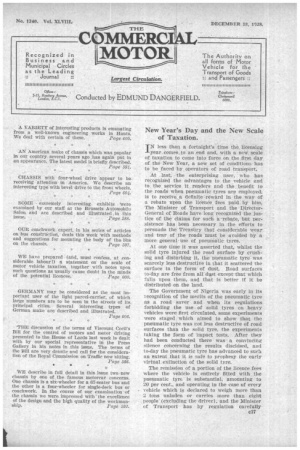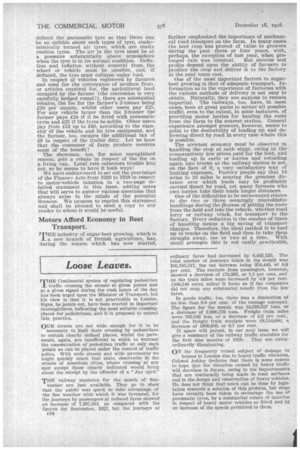New Year's Day and the New Scale
Page 1

Page 2

If you've noticed an error in this article please click here to report it so we can fix it.
of Taxation.
TN less than a fortnight's time the licensing year comes to an .end and, with a new. scale of taxation to come into force on the first day of the New Year, a new set of conditions has to be faced by operators of road transport. • At last, the enterprising user, who has recognized the advantages to the vehicle and to. the service, it renders and the _benefit to the roads when pneumatic tyres are einployecl; is to receiva_a definite "reward in the way. of a rebate upon the licence fees paid by him. The Minister of Transport and the DirectorGeneral of Roads have long recognized the justice Of the: claims for . strati -rebate, but persistence has been necessary in the efforts to persuade the Treasury that considerable wear and tear of the, roads must be avoided by a more general use of pneumatic tyres.
At one time it was asserted that, whilst the solid tyre injured the road surface by crushing and disturbing it, the pneumatic tyre" was scarcely less destructive in that it scattered the surface in the form of dust. Road surfaces to-day are free from all dust except that which falls upon them, and that is better if it be distributed on the land.
The Government of Nigeria was early in its recognition of the merits of the pneumatic tyre as a road sayer and when its regulations forbidding the use of solid tyres on heavy Vehicles were first circulated, some experiments were staged which aimed to show that the pneumatic tyre was not less destructive of road surfaces than the solid tyre, the experiments taking the form of impact tests. After they had been conducted there was' a convincing silence concerning the results dischised, and to-day the pneumatic tyre has advanced to such an extent that it is safe to prophesy the early virtual .extinction of the solid tyre.
The remission of a portion of the licence fees Where the vehicle is entirely fitted with the pneumatic tyre is substantial, amounting to 20 per cent., and operating in the case of every . vehicle which is declared to weigh more than 2 tons unladen or carries more than eight people" (excluding the driver), -and the Minister of Transport has by regulation carefully c17 defined the pneumatic tyre so that there can be no quibble about such types of tyre, euphemistically termed ale tyres, which are really cushion tyres. The air in the tyre must be at a pressure substantially above atmosphere when the tyre is in its normal condition. Deflation and inflation without removal from the wheel or vehicle must be possible, and, if deflated, the tyre must collapse under load.
In respect of vehicles registered by farmers and used for the conveyance of produce from, or articles required for, the agricultural land occupied by the farmer (the concession is very carefully hedged round !), there are substantial rebates, the fee for the farmer's 2-tonner being £20 per annum, whilst other users pay £23. For any vehicle larger than the 2-tonner the farmer pays £20 if it be fitted with pneumatic tyres and £25 If the tyres be solids. Other users pay from £32 up to £60, according to the capacity of the vehicle and its tyre equipment, and the farmer, too, escapes the additional tax of £6 in respect of the trailer duty. Let us hope that the consumer of farm produce receives some of the benefit !
The showman, too, for some unexplained reason, gets a rebate in respect of the fee on a living van. Local rate collectors trouble him not, so he seems to have it both ways !
We have endeavoured to set out the provisions of the Finance Acts from 1920 to 1928 in respect to motor-vehicle taxation in a two-page detailed statement in this issue, adding notes that will serve to answer various questions that always arise in the minds of the potential licencee. We propose to reprint this statement and shall be pleased to send a copy to any reader to whom it would be useful.
Motors Afford Economy in Beet Transport.
THE industry of sugar-beet growing, which is a new branch of British agriculture, has, during the season which has now started,
further emphasized the importance of mechanical road transport on the farm. In many cases the beet crop has proved of value to growers during the past three or four years, with, perhaps, the exception of last year, when pro longed rain was inimical. But success and profits depend upon the ability of farmers to produce the crop and deliver it to the factory at the mini mum cost.
One of the most important factors in sugarbeet growing is that of adequate transport. Information as to the experience of factories with the various methods of delivery is not easy to obtain. Naturally, they are anxious to remain impartial. The railways, too, have, in most eases, been at great pains to secure all possible traffic, even to the extent, in some instances, of providing motor lorries for hauling the roots from the farm to the nearest station. General experience amongst growers, however, seems to point to the desirability of loading up and delivering direct by road in every case where this is possible.
The strictest economy must be observed in handling the crop at each stage, owing to the comparatively low prices paid for the beet, and loading up in carts or lorries and reloading again into trucks at the railway station is not, on the face of it, a very satisfactory way of limiting expenses. Factory people say that 18 miles to 20 miles is nearing the greatest distance over which loads may be profitably carried direct by road, yet many farmers who own lorries take their loads longer distances.
One of the difficulties to be surmounted relates to the two or three seemingly unavoidable handlings during the ftrocess of getting the roots from the field and into the vehicle, whether road lorry or railway truck, for transport to the factory. Every reduction in the number Of times of handling means a big saving of transport charges. Therefore, the ideal method is to load up in trucks on the field and then to take them straight away, one or two at a time. With small acreages this is not easily practicable,
































